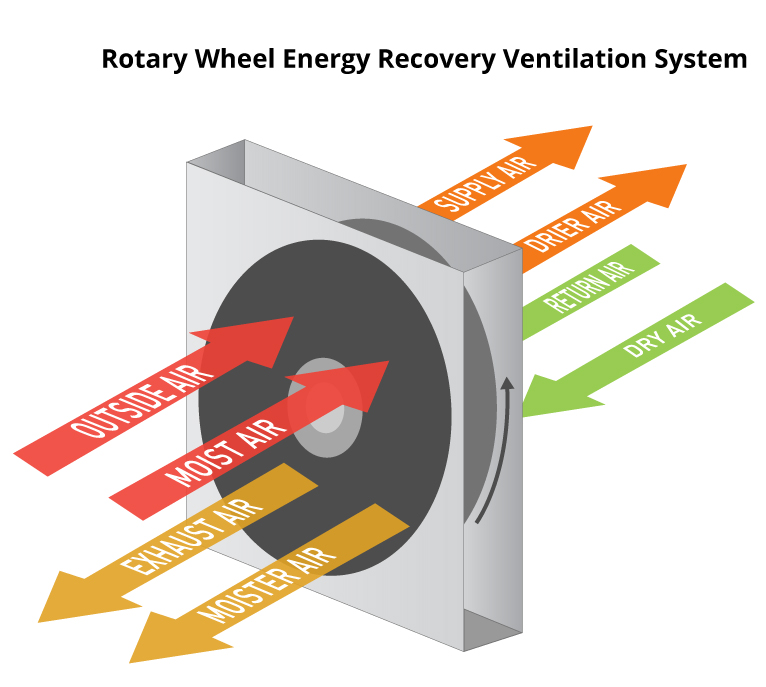Commercial and residential buildings account for nearly 40% of U.S. energy consumption according to the Environmental Protection Agency, so increasing efficiency is an important priority. Conserving energy to make buildings more “green” must also be balanced with maintaining a healthy and productive indoor environment. Energy recovery ventilation (ERV) technology can deliver both of these needs. ERV systems are one of the most cost-efficient and sustainable solutions for significantly reducing building energy consumption.
The ABC’s of ERV Technology
ERV is an energy recovery process that exchanges the energy contained in normally exhausted building air and uses it to heat, cool, humidify or de-humidify the incoming outdoor air in HVAC systems. ERV systems can dramatically reduce energy costs and loads on air conditioning and heating systems by pre-cooling or pre-heating the incoming air. The use of ERV systems in buildings can also maintain relative humidity and scale down the need for other HVAC equipment. The two most common ERV systems include:
Plate Heat Exchanger Systems: Plate heat exchanger systems have no moving parts. They use alternating layers of membranes/plates that are separated and sealed. Plate systems include multiple sheets of membrane material and counter-current airflow to exchange heat and humidity. The membrane keeps the incoming fresh air from being contaminated by outgoing stale air.
 Rotary Wheel Heat Exchanger Systems: Rotary wheel heat exchanger systems consist of a rotating cylinder filled with an air-permeable material. The resulting large surface area is used as a medium for both sensible and latent energy transfer. The wheel sections rotate between ventilation and exhaust air streams, picking up and releasing heat energy into the colder air stream. The most common medium used for the wheel heat exchanger system is a polymer, in combination with a desiccant that absorbs and releases humidity.
Rotary Wheel Heat Exchanger Systems: Rotary wheel heat exchanger systems consist of a rotating cylinder filled with an air-permeable material. The resulting large surface area is used as a medium for both sensible and latent energy transfer. The wheel sections rotate between ventilation and exhaust air streams, picking up and releasing heat energy into the colder air stream. The most common medium used for the wheel heat exchanger system is a polymer, in combination with a desiccant that absorbs and releases humidity.
Coating ERV Membranes and Films
Carestream Contract Manufacturing’s deep experience with precision coating methods and high-speed, wide-web assets and technologies bring high yield and cost advantages to the ERV market. Carestream works with companies developing new solvent cast polymer membranes used in plate systems and coated films for rotating wheel systems to help design, develop and manufacture appropriate coatings.
Typically the specialty polymers used to create ERV membranes or films are coated from solvent-based solutions. Carestream’s Coating Assessment Lab measures solution properties and models coatings to optimize equipment-fluid design and interactions for process robustness and product quality.
The key quality properties needed for ERV membranes and films include:
- Tight thickness uniformity
- Very low level of gels or pinholes
- High moisture vapor transmission rate (MVTR)
- Good tensile strength
- Low retained solvent
Carestream’s precision coating methods deliver +/-5% cross-web and down-web thickness consistency. Clean room manufacturing practices and micron-level solution filtration help to avoid coating defects like dust, gels and pinholes, which could cause air leaks in an ERV system. On-line laser and camera-based inspection systems provide secondary verification of the coating quality, and advanced analytical techniques stand ready to troubleshoot the cause of any defect.
Carestream’s multi-zone dryer temperature control enables gentle initial drying to avoid skinning and airflow-induced surface imperfections. Carestream’s extensive dryer length gives the polymer time to coagulate or solidify gradually, optimizing internal structure for enhanced MVTR and tensile strength without sacrificing line speed, to keep costs down. This drying profile also minimizes retained solvent in the final membrane or coated film to avoid odor and health concerns.
Thin substrates and release liners can create unexpected manufacturing problems, such as tearing, wrinkling, creasing, stretching and more, which may ultimately reduce efficiency, yield and product quality. Carestream’s equipment investments, sophisticated process controls, engineering expertise and supplier relationships overcome these challenges for the highest-performance ERV applications. Carestream can also provide in-line lamination for those applications where a secondary substrate needs to be married with the coated ERV membrane. Please contact Todd Arndorfer to get started.
